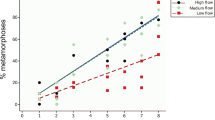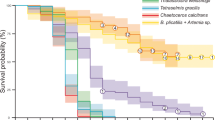Abstract
The rapa whelk Rapana venosa transforms from a phytophagous larva to a carnivorous juvenile after settlement and metamorphosis. The high mortality rate and low metamorphosis rate (<1%) of larvae are among the key factors limiting the recovery of the resources of R. venosa. We studied these two processes and showed that the larva has the ability to settle and metamorphose in the middle and late 4 spiral whorl period, and the use of substrates (scallop shells with oysters) can significantly improve the settlement and metamorphosis rate of larvae. The presence of darkness, juvenile bivalve shellfish, and oyster polysaccharide could effectively increase the rates of larval settlement and metamorphosis. Our findings broaden the understanding of settlement and metamorphosis in gastropods and can be used to improve population control, resource recovery and commercial breeding strategies for R. venosa.
Similar content being viewed by others
References
Bao Y B, You Z J. 2004. Influences of several environmental factors on growth in marine shellfish larvae. Fisheries Science, 23(12): 39–41. (in Chinese with English abstract)
Barlow L A, Truman J W. 1992. Patterns of serotonin and SCP immunoreactivity during metamorphosis of the nervous system of the red abalone, Haliotis rufescens. Journal of Neurobiology, 23(7): 829–844.
Biscocho D, Cook J G, Long J, Shah N, Leise E M. 2018. GABA is an inhibitory neurotransmitter in the neural circuit regulating metamorphosis in a marine snail. Developmental Neurobiology, 78(7): 736–753.
Burke R D. 1983. The induction of metamorphosis of marine invertebrate larvae: stimulus and response. Canadian Journal of Zoology, 61(8): 1 701–1 719.
Cole W C, Youson J H. 1981. The effect of pinealectomy, continuous light, and continuous darkness on metamorphosis of anadromous sea lampreys, Petromyzon marinus L. Journal of Experimental Zoology, 218(3): 397–404.
Coon S L, Bonar D B, Weiner R M. 1985. Induction of settlement and metamorphosis of the pacific oyster, Crassostrea gigas (Thunberg), by L-DOPA and catecholamines. Journal of Experimental Marine Biology and Ecology, 94(1–3): 211–221.
Fitt W K, Coon S L, Walch M, Weiner R M, Colwell R R, Bonar D B. 1990. Settlement behavior and metamorphosis of oyster larvae (Crassostrea gigas) in response to bacterial supernatants. Marine Biology, 106(3): 389–394.
Gao X L, Li X, Zhang M, Chi L, Song C B, Liu Y. 2016. Effects of LED light quality on the growth, survival and metamorphosis of Haliotis discus hannai Ino larvae. Aquaculture Research, 47(12): 3 705–3 717.
Harding J M. 2006. Growth and development of veined RAPA whelk Rapana venosa veligers. Journal of Shellfish Research, 25(3): 941–946.
Jackson D, Leys S P, Hinman V F, Woods R, Lavin M F, Degnan B M. 2002. Ecological regulation of development: induction of marine invertebrate metamorphosis. The International Journal of Developmental Biology, 46(4): 679–686.
Kirchman D, Graham S, Reish D, Mitchell R. 1981. Bacteria induce settlement and metamorphosis of Janua (Dexiospira) brasiliensis Grube (Polychaeta: Spirprbidae). Journal of Experimental Marine Biology and Ecology, 56(2–3): 153–163.
Laimek P, Clark S, Stewart M, Pfeffer F, Wanichanon C, Hanna P, Sobhon P. 2008. The presence of GABA in gastropod mucus and its role in inducing larval settlement. Journal of Experimental Marine Biology and Ecology, 354(2): 182–191.
Leise E M, Cahoon L B. 2012. Neurotransmitters, benthic diatoms and metamorphosis in a marine snail. In: Hämäläinen E M, Järvinen S eds. Snails: Biology, Ecology and Conservation. Nova Publishers, Hauppage, NY p.1–43.
Li H F, Lin W, Zhang G, Cai Z H, Cai G P, Chang Y Q, Xing K Z. 2006. Enhancement of larval settlement and metamorphosis through biological and chemical cues in the abalone Haliotis diversicolor supertexta. Aquaculture, 258(1–4): 416–423.
Liang F L, Mao Y, Yu X Y, Liu H J. 2005. Experiment on artificial breeding of Babylonia areolata (Lamrck). Transactions of Oceanology and Limnology, (1): 79–85. (in Chinese with English abstract)
Liu X J, Yu R H, Li Q, An J T, Wang C B, Liu J, Kong J. 2015. Study on Indoor nursery culture of Rapana venosa (Valenciennes). Transactions of Oceanology and Limnology, (2): 68–74. (in Chinese with English abstract)
Morse A N C, Morse D E. 1996. Flypapers for coral and other planktonic larvae: New materials incorporate morphogens for applications in research, restoration, aquaculture, and medicine. Bioscience, 46(4): 254–262.
Morse D E, Hooker N, Duncan H, Jensen L. 1979. γ-Aminobutyric acid, a neurotransmitter, induces planktonic abalone larvae to settle and begin metamorphosis. Science, 204(4391): 407–410.
Morse D E, Morse A N C. 1991. Enzymatic characterization of the morphogen recognized by Agaricia humilis (scleractinian coral) larvae. The Biological Bulletin, 181(1): 104–122.
Pan Y, Qiu T, Zhang T, Wang P, Ban S. 2013a. Morphological studies on the early development of Rapana venosa. Journal of Fisheries of China, 37(10): 1 503–1 512. (in Chinese with English abstract)
Pan Y, Zhang L B, Zhang T, Wang P C, Pan H Q, Ban S J, Bi K Z. 2013b. Attraction of animal diets to the larvae of Rapana venosa. Oceanologia et Limnologia Sinica, 44(6): 1 578–1 583. (in Chinese with English abstract)
Pechenik J A. 1990. Delayed metamorphosis by larvae of benthic marine invertebrates: does it occur? Is there a price to pay? Ophelia, 32(1–2): 63–94.
Rodríguez S R, Ojeda F P, Inestrosa N C. 1993. Settlement of benthic marine invertebrates. Marine Ecology Progress Series, 97: 193–207.
Sánchez-Lazo C, Martínez-Pita I. 2012. Induction of settlement in larvae of the mussel Mytilus galloprovincialis using neuroactive compounds. Aquaculture, 344–349: 210–215.
Searcy-Bernal R, Salas-Garza A E, Flores-Aguilar R A, Hinojosa-Rivera P R. 1992. Simultaneous comparison of methods for settlement and metamorphosis induction in the red abalone (Haliotis rufescens). Aquaculture, 105(3–4): 241–250.
Shi X, Ma H H, Tong C Q, Qu M, Jin Q, Li W. 2015. Hepatoprotective effect of a polysaccharide from Crassostrea gigas on acute and chronic models of liver injury. International Journal of Biological Macromolecules, 78: 142–148.
Song H, Sun L Y, Yu Z L, Sun L N, Xue D X, Zhang T, Wang H Y. 2016a. Metabolomic analysis of competent larvae and juvenile veined rapa whelks (Rapana venosa). Marine Biology, 163(6): 145.
Song H, Yu Z L, Sun L N, Gao Y, Zhang T, Wang H Y. 2016b. De novo transcriptome sequencing and analysis of Rapana venosa from six different developmental stages using Hi-seq 2500. Comparave Biochemistry and Physiology Part D: Genomics and Proteomics, 17: 48–57.
Song H, Yu Z L, Sun L N, Xue D X, Zhang T, Wang H Y. 2016c. Transcriptomic analysis of differentially expressed genes during larval development of Rapana venosa by digital gene expression profiling. G3: Genes, Genomes, Genetics, 6(7): 2 181–2 193.
Taris N, Comtet T, Stolba R, Lasbleiz R, Pechenik J A, Viard F. 2010. Experimental induction of larval metamorphosis by a naturally-produced halogenated compound (dibromomethane) in the invasive mollusc Crepidula fornicata (L.). Journal of Experimental Marine Biology and Ecology, 393(1–2): 71–77.
Wang C, Bao W Y, Gu Z Q, Li Y F, Liang X, Ling Y, Cai S L, Shen H D, Yang J L. 2012. Larval settlement and metamorphosis of the mussel Mytilus coruscus in response to natural biofilms. Biofouling, 28(3): 249–256.
Wang J, Wu C L, Xu C L, Yu W C, Li Z, Li Y C, Guo T, Wang X T. 2015. Voltage-gated potassium ion channel may play a major role in the settlement of Pacific oyster (Crassostrea gigas) larvae. Aquaculture, 442: 48–50.
Watnick P, Kolter R. 2000. Biofilm, city of microbes. Journal of Bacteriology, 182(10): 2 675–2 679.
Wei L P, Qiu S Y, Wang B G, Sun X F, Wang X D. 1999. Studies on the reproductive biology of Rapana venosa. Journal of Fisheries of China, 23(2): 150–155. (in Chinese with English abstract)
Yang D Z, Zhou Y B, Guan Z C, Zhao F F. 2007. Technique for industrial breeding in Rapana venosa valenciennes. Fisheries Science, 26(4): 237–239. (in Chinese with English abstract)
Yang Z P, Yu H, Yu R H, Kong L F, Li Q. 2016. Studies on larval metamorphosis and feed conversion of Rapana venosa. Journal of Fisheries of China, 40(9): 1 472–1 478. (in Chinese with English abstract)
Yang Z P, Yu H, Yu R H, Li Q. 2015. Induced metamorphosis in larvae of the veined RAPA whelk Rapana venosa using chemical cues. Marine Biology Research, 11(10): 1 085–1 092.
Yu Z L, Wang H, Song H, Bai Y C, Sun J C, Qian Y S, Hu N, Yang M J, Zhang T. 2018. Cannibalism by the juveniles of the gastropod Rapana venosa (Muricidae) reared under laboratory conditions. Journal of Molluscan Studies, 84(3): 303–309.
Yuan C Y. 1992. Primary exploration on aquaculture of Rapana venosa I—Artificial seedling collection technique of Rapana venosa in natural sea area. Fisheries Science, 11(9): 16–18. (in Chinese)
Acknowledgment
We thank Dr. YANG Pan for experiment suggestions and valuable advice in writing the article.
Author information
Authors and Affiliations
Contributions
ZHANG Tao conceived and designed the experiments. YU Zhenglin and YANG Meijie performed the experiments. YU Zhenglin analyzed the data. YANG Meijie, SONG Hao, HU Zhi, ZHOU Cong, WANG Xiaolong, and LI Haizhou contributed reagents, materials, and analytical tools. YU Zhenglin wrote the manuscript.
Corresponding author
Additional information
Supported by the National Natural Science Foundation of China (No. 31572636), the Natural Science Foundation of Shandong Province (No. ZR2019BD003), the China Postdoctoral Science Foundation (No. 2019M652498), the Earmarked Fund for Modern Agro-industry Technology Research System (No. CARS-49), the Special Funds for Talent Project of Taishan Industry Leader, the ‘Double Hundred’ Blue Industry Leader Team of Yantai, and the Creative Team Project of the Laboratory for Marine Ecology and Environmental Science, Qingdao National Laboratory for Marine Science and Technology (No. LMEES-CTSP-2018-1)
Rights and permissions
About this article
Cite this article
Yu, Z., Yang, M., Song, H. et al. Settlement and metamorphosis of Rapana venosa (Gastropoda: Muricidae) with implications for artificial culture. J. Ocean. Limnol. 38, 249–259 (2020). https://doi.org/10.1007/s00343-019-9107-8
Received:
Accepted:
Published:
Issue Date:
DOI: https://doi.org/10.1007/s00343-019-9107-8




